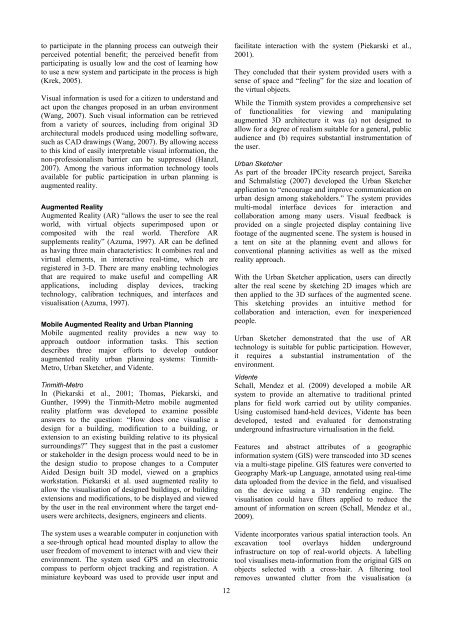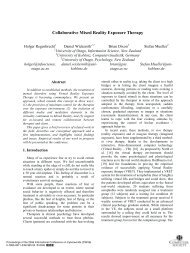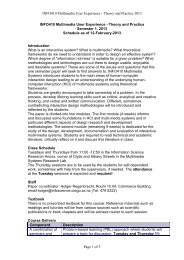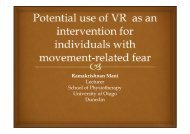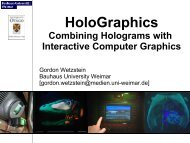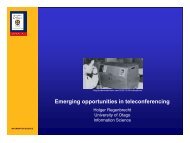Smart-phone augmented reality for public participation in urban ...
Smart-phone augmented reality for public participation in urban ...
Smart-phone augmented reality for public participation in urban ...
Create successful ePaper yourself
Turn your PDF publications into a flip-book with our unique Google optimized e-Paper software.
to participate <strong>in</strong> the plann<strong>in</strong>g process can outweigh their<br />
perceived potential benefit; the perceived benefit from<br />
participat<strong>in</strong>g is usually low and the cost of learn<strong>in</strong>g how<br />
to use a new system and participate <strong>in</strong> the process is high<br />
(Krek, 2005).<br />
Visual <strong>in</strong><strong>for</strong>mation is used <strong>for</strong> a citizen to understand and<br />
act upon the changes proposed <strong>in</strong> an <strong>urban</strong> environment<br />
(Wang, 2007). Such visual <strong>in</strong><strong>for</strong>mation can be retrieved<br />
from a variety of sources, <strong>in</strong>clud<strong>in</strong>g from orig<strong>in</strong>al 3D<br />
architectural models produced us<strong>in</strong>g modell<strong>in</strong>g software,<br />
such as CAD draw<strong>in</strong>gs (Wang, 2007). By allow<strong>in</strong>g access<br />
to this k<strong>in</strong>d of easily <strong>in</strong>terpretable visual <strong>in</strong><strong>for</strong>mation, the<br />
non-professionalism barrier can be suppressed (Hanzl,<br />
2007). Among the various <strong>in</strong><strong>for</strong>mation technology tools<br />
available <strong>for</strong> <strong>public</strong> <strong>participation</strong> <strong>in</strong> <strong>urban</strong> plann<strong>in</strong>g is<br />
<strong>augmented</strong> <strong>reality</strong>.<br />
Augmented Reality<br />
Augmented Reality (AR) “allows the user to see the real<br />
world, with virtual objects superimposed upon or<br />
composited with the real world. There<strong>for</strong>e AR<br />
supplements <strong>reality</strong>” (Azuma, 1997). AR can be def<strong>in</strong>ed<br />
as hav<strong>in</strong>g three ma<strong>in</strong> characteristics: It comb<strong>in</strong>es real and<br />
virtual elements, <strong>in</strong> <strong>in</strong>teractive real-time, which are<br />
registered <strong>in</strong> 3-D. There are many enabl<strong>in</strong>g technologies<br />
that are required to make useful and compell<strong>in</strong>g AR<br />
applications, <strong>in</strong>clud<strong>in</strong>g display devices, track<strong>in</strong>g<br />
technology, calibration techniques, and <strong>in</strong>terfaces and<br />
visualisation (Azuma, 1997).<br />
Mobile Augmented Reality and Urban Plann<strong>in</strong>g<br />
Mobile <strong>augmented</strong> <strong>reality</strong> provides a new way to<br />
approach outdoor <strong>in</strong><strong>for</strong>mation tasks. This section<br />
describes three major ef<strong>for</strong>ts to develop outdoor<br />
<strong>augmented</strong> <strong>reality</strong> <strong>urban</strong> plann<strong>in</strong>g systems: T<strong>in</strong>mith-<br />
Metro, Urban Sketcher, and Vidente.<br />
T<strong>in</strong>mith-Metro<br />
In (Piekarski et al., 2001; Thomas, Piekarski, and<br />
Gunther, 1999) the T<strong>in</strong>mith-Metro mobile <strong>augmented</strong><br />
<strong>reality</strong> plat<strong>for</strong>m was developed to exam<strong>in</strong>e possible<br />
answers to the question: “How does one visualise a<br />
design <strong>for</strong> a build<strong>in</strong>g, modification to a build<strong>in</strong>g, or<br />
extension to an exist<strong>in</strong>g build<strong>in</strong>g relative to its physical<br />
surround<strong>in</strong>gs?” They suggest that <strong>in</strong> the past a customer<br />
or stakeholder <strong>in</strong> the design process would need to be <strong>in</strong><br />
the design studio to propose changes to a Computer<br />
Aided Design built 3D model, viewed on a graphics<br />
workstation. Piekarski et al. used <strong>augmented</strong> <strong>reality</strong> to<br />
allow the visualisation of designed build<strong>in</strong>gs, or build<strong>in</strong>g<br />
extensions and modifications, to be displayed and viewed<br />
by the user <strong>in</strong> the real environment where the target endusers<br />
were architects, designers, eng<strong>in</strong>eers and clients.<br />
The system uses a wearable computer <strong>in</strong> conjunction with<br />
a see-through optical head mounted display to allow the<br />
user freedom of movement to <strong>in</strong>teract with and view their<br />
environment. The system used GPS and an electronic<br />
compass to per<strong>for</strong>m object track<strong>in</strong>g and registration. A<br />
m<strong>in</strong>iature keyboard was used to provide user <strong>in</strong>put and<br />
12<br />
facilitate <strong>in</strong>teraction with the system (Piekarski et al.,<br />
2001).<br />
They concluded that their system provided users with a<br />
sense of space and “feel<strong>in</strong>g” <strong>for</strong> the size and location of<br />
the virtual objects.<br />
While the T<strong>in</strong>mith system provides a comprehensive set<br />
of functionalities <strong>for</strong> view<strong>in</strong>g and manipulat<strong>in</strong>g<br />
<strong>augmented</strong> 3D architecture it was (a) not designed to<br />
allow <strong>for</strong> a degree of realism suitable <strong>for</strong> a general, <strong>public</strong><br />
audience and (b) requires substantial <strong>in</strong>strumentation of<br />
the user.<br />
Urban Sketcher<br />
As part of the broader IPCity research project, Sareika<br />
and Schmalstieg (2007) developed the Urban Sketcher<br />
application to “encourage and improve communication on<br />
<strong>urban</strong> design among stakeholders.” The system provides<br />
multi-modal <strong>in</strong>terface devices <strong>for</strong> <strong>in</strong>teraction and<br />
collaboration among many users. Visual feedback is<br />
provided on a s<strong>in</strong>gle projected display conta<strong>in</strong><strong>in</strong>g live<br />
footage of the <strong>augmented</strong> scene. The system is housed <strong>in</strong><br />
a tent on site at the plann<strong>in</strong>g event and allows <strong>for</strong><br />
conventional plann<strong>in</strong>g activities as well as the mixed<br />
<strong>reality</strong> approach.<br />
With the Urban Sketcher application, users can directly<br />
alter the real scene by sketch<strong>in</strong>g 2D images which are<br />
then applied to the 3D surfaces of the <strong>augmented</strong> scene.<br />
This sketch<strong>in</strong>g provides an <strong>in</strong>tuitive method <strong>for</strong><br />
collaboration and <strong>in</strong>teraction, even <strong>for</strong> <strong>in</strong>experienced<br />
people.<br />
Urban Sketcher demonstrated that the use of AR<br />
technology is suitable <strong>for</strong> <strong>public</strong> <strong>participation</strong>. However,<br />
it requires a substantial <strong>in</strong>strumentation of the<br />
environment.<br />
Vidente<br />
Schall, Mendez et al. (2009) developed a mobile AR<br />
system to provide an alternative to traditional pr<strong>in</strong>ted<br />
plans <strong>for</strong> field work carried out by utility companies.<br />
Us<strong>in</strong>g customised hand-held devices, Vidente has been<br />
developed, tested and evaluated <strong>for</strong> demonstrat<strong>in</strong>g<br />
underground <strong>in</strong>frastructure virtualisation <strong>in</strong> the field.<br />
Features and abstract attributes of a geographic<br />
<strong>in</strong><strong>for</strong>mation system (GIS) were transcoded <strong>in</strong>to 3D scenes<br />
via a multi-stage pipel<strong>in</strong>e. GIS features were converted to<br />
Geography Mark-up Language, annotated us<strong>in</strong>g real-time<br />
data uploaded from the device <strong>in</strong> the field, and visualised<br />
on the device us<strong>in</strong>g a 3D render<strong>in</strong>g eng<strong>in</strong>e. The<br />
visualisation could have filters applied to reduce the<br />
amount of <strong>in</strong><strong>for</strong>mation on screen (Schall, Mendez et al.,<br />
2009).<br />
Vidente <strong>in</strong>corporates various spatial <strong>in</strong>teraction tools. An<br />
excavation tool overlays hidden underground<br />
<strong>in</strong>frastructure on top of real-world objects. A labell<strong>in</strong>g<br />
tool visualises meta-<strong>in</strong><strong>for</strong>mation from the orig<strong>in</strong>al GIS on<br />
objects selected with a cross-hair. A filter<strong>in</strong>g tool<br />
removes unwanted clutter from the visualisation (a


